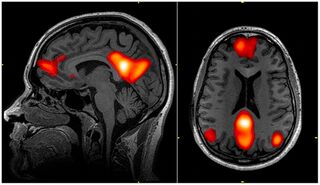Anxiety
Anxiety and Your Resting Brain
Changes in the default mode network and anxiety.
Posted February 26, 2022 Reviewed by Lybi Ma
Key points
- Anxious apprehension can be thought of as a more cognitive form of anxiety.
- Activity in the Default Mode Network may predict anxious apprehension and arousal.
- Perhaps, chronic worriers are engaging in repetitive concern about what has not yet happened.
Anxiety is, unfortunately, familiar to all of us. That feeling of being out of control, of doubting whether we can handle whatever is headed our way can make us feel nervous, worried, and uneasy. Researchers Burdwood, Infantolino et al. (2016) have been examining how different forms of anxiety are linked to different patterns of brain activation. These researchers focused on two general and overarching categories of anxiety: anxious apprehension and anxious arousal.
Anxious apprehension can be thought of as a more cognitive form of anxiety, characterized by worry about the future, an inward focus and repetitive thinking. Sufferers of anxious apprehension are usually described as frequent worriers, often very pensive with a tendency toward introspection. Anxious arousal is more physical and outwardly focused, characterized by shortness of breath, an increased heart rate, vigilance, and heightened monitoring of the world around us. Sufferers of this form of anxiety are scanning their environment for threats, even when they are at rest.

FMRI scans provide researchers with maps of brain activity, typically as we are thinking and problem-solving. However, our brains are never really still. They’re also active when we’re not really doing much of anything. Recent research has suggested that there are two general patterns of brain activation. One system of brain regions is activated when our attention is externally focused and we’re working on a task (a Task-Related Network). Another network, called the Default Mode Network, or DMN, is active when we’re not engaged in a particular task, and our attention is inwardly focused. You can think of activity in the DMN as a sort of baseline brain activity (see the image here). Activity in the DMN decreases when we’re actively engaged in a task, and activity in the Task-Related Network decreases when we’re at rest. Burdwood et al. hypothesized that activity patterns in the DMN might provide insight into maladaptive patterns of thought that are present even when we’re at rest.
Burdwood and colleagues hypothesized that because anxious apprehension involves a generally inward focus of attention, and attention when we’re at rest is also generally inwardly focused, they ought to see an increase in activity patterns in the DMN in anxious apprehension. By the same token, because anxious arousal is characterized by outward attention, they predicted that activity patterns in the DMN would be decreased in this of anxiety.
Changes in the DMN in Anxiety
Volunteers were given several questionnaires designed to assess anxiety and were separated into control, anxious apprehension, and anxious arousal groups on the basis of their scores. While in the fMRI scanner, they were asked to complete the color-word and emotion-word Stroop task where they identified the color of the word and ignored the meaning of the word (for example, the word green in the color-word task or the word joy in the emotion task). Scans were obtained both for the task and during rest periods between the presentations of the task allowing assessment of both the Task-Related Network and the DMN.
What the researchers predicted turned out to be the opposite of what they saw. Anxious apprehension was associated with a decrease in DMN activity suggesting a decrease in inwardly focused thought. Perhaps the kind of inward thinking and worry sufferers of anxious apprehension are feeling is not particularly introspective and self-referential. It may be that chronic worriers are engaging in repetitive concern about the future and what has not yet happened, rather than a more adaptive concern with the present moment typically associated with high levels of DMN activation.
Anxious arousal was associated with an increase in DMN activity, suggesting a higher level of internal focus of attention, not the lower level that was initially predicted. Burdwood et al. speculated that perhaps the focus for these participants during periods of rest was on monitoring their own anxiety symptoms. Proprioception, or awareness of our own bodies, requires that attention be directed inwardly and this may be reflected in activity patterns in the DMN.
It should be noted that the debate about whether the DMN actually reflects resting-state activity in the brain is ongoing, but it has also been suggested that effective therapy for disorders like anxiety and depression may be effective in part because they alter activity in the DMN.
References
Burdwood, E.N., Infantolino, Z.P., Crocker, L.D., Spielberg, J.M., Banich, M.T., Miller, G.A., and Heller, W. (2016). Resting-State functional connectivity differentiates anxious apprehension and anxious arousal, Psychophysiology, 53(10), 1451-1459. doi:10.1111/psyp.12696.


